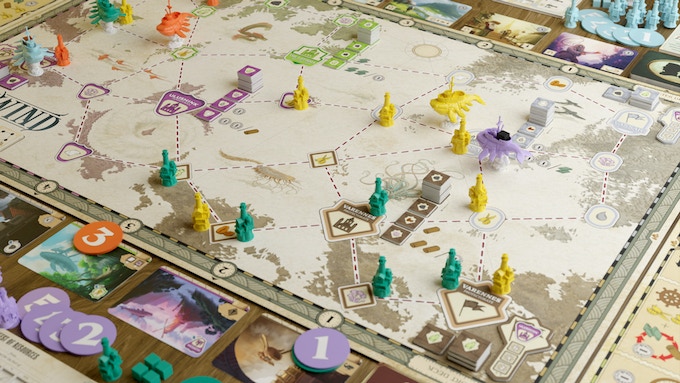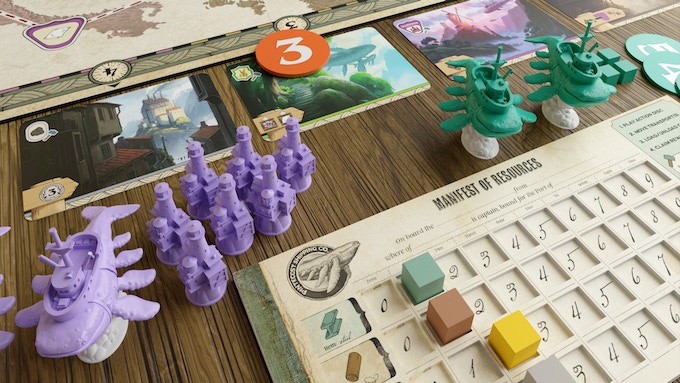Preview: Sail the Skies & Establish Trade Routes in Mistwind

In this mystical pick-up-and-deliver gem from designers Adrian Adamescu and Daryl Andrews (Sagrada) and publisher First Fish Games, players will create trade routes in the vast regions of Mistwind Islands by harnessing the towing power of flying whales.
This is a paid preview of Mistwind, in which we will dive into the game based on its current ruleset and prototype pieces. You can find more information and potentially support the project on Kickstarter right now.

Photo provided by the publisher
Gameplay
Mistwind is a 1-5 player game in which players work to become the biggest and best traders among the Mistwind Islands. Players begin with a Manifest of Resources board, starting with one steel, one lumber, and two coins. The starting amount of krill is determined by player order, starting with one for the first player and increasing by player order. Collect the outposts, whale transports, action discs, and network markers in your chosen color and play may begin with the first player.
During their turn, players will utilize player discs (numbered 1-5) and action selection to maximize the needs of each port by collecting and delivering goods, earning rewards, and turning those rewards into means to expand their trading networks to link up the regions of the Mistwind Islands. To do this, players will select four of their five discs from a shuffled, face-down stack and discard one of their choice. These numbers correspond to one of the four areas around the board that will allow players to gather resources to expand trade networks, recruit people to give them one-time or ongoing help, or carry out actions that will help them conduct business or make exchanges or conduct and construct at the various cities and ports across the Mistwind Islands.
Players will reveal the value of a disc and place it in the spot in one of these four areas and take the action. Let’s go over each of these areas and what is achieved or gained by visiting each.
Character Cards offer players the chance to claim a character by paying the cost shown and gaining their ability. These may be instant, used one time at the player’s discretion, ongoing, or at game’s end. When placing a disc, the number of the disc must correspond with the Character Card the player wants to purchase. If a player has already played the same numbered disc and claimed the card, players must either use a different number disc for a different character or chose another action elsewhere.
The Resource Board allows players to gain the resources of a given space. Similar to the Character Card area, players may not stack discs to take the resources another player has already claimed.
The Labour Board allows players to pay the cost shown and perform the associated action, which includes a port bonus from the Port Area. These benefits may help players if they are out of the necessary resources or want to maximize their gains from another area or on the board. Players may not stack discs here to take actions already selected by previous players.
Port Cards allow players to build outposts or whale transports on the chosen port selected by their disc. They must pay the cost and place the transport or outpost depicted on the Port Card. Unlike the other areas, players may stack discs on the same Port Card. The player with their disc on top will be able to take the printed port bonus on the cards at the end of the round.
These area actions correlate to how players will expand their burgeoning trade routes across the Mistwind Islands. Resources such as steel and lumber are necessary for building transport depots in cities and ports. These resources are also required to build new whale transports to collect and move trade cargo among the four regions. Krill is necessary fuel for whale transports, as any location that does not have a transport depot will require one krill per movement. So, it’s valuable to gain what’s needed to maximize one’s turns during each round.
Once whale transports are out on the board (each player has a total of three), players can then travel to ports, gain the printed trade good (such as coffee, fungus, cotton, etc.) and then transport it to a city that wants it. However, there are rewards based on the need of the goods that cities desire, which rotate based on when something is fulfilled. If a good has low demand, it will reward players with no immediate gain. However, other goods further down the list will provide greater resource gain for further expansion. The good news is collecting any goods token for fulfilling it will result in a point at the end of the game, and these tiles may be useful in meeting the requirements of one of the four random goals selected at the start of the game. Whales can only carry one good at a time unless they land on a krill port (which will gain players one krill on their Manifest of Resources board).

Photo provided by the publisher
Players are also working to connect networks determined by their secret Network Cards, which are randomly selected at the beginning of the game. They are also working to be the first to complete one of the four achievements from the Achievement Token area of the board. Once a player has completed it, they will claim the tile. Finally, if a player has fulfilled the requirements on one of the assigned Nation Network titles placed by each major city at the game’s beginning, they will place one of their network markers on the available slot with the highest points. Players may only have one network marker per region.
Once a player has played a disc and taken the resources or action(s) associated with the spot chosen, the next player in clockwise order will go. Once all players have played their discs and taken their actions, the highest discs on any Port Card stacks will claim the port bonuses. All action discs are regained, and the remaining Port and Character Cards will be discarded, and five new cards will be dealt out in each area. Players will shuffle their five action discs, select four and choose one to discard, and then resume, starting with the first player until the end of the four rounds (five rounds for five players). Then points will be totaled from cargo collected, having the most cargo per region, any gained achievement, finishing network cards and claimed nation network spots, and any victory points gained from purchased characters. The player with the most victory points is the best trader across the Mistwind Islands. Ties are broken by the amount of remaining wood and steel in one’s supply.
Review
Despite being prototype art, the immediate draw of Mistwind is the graphical palette of Gorden Oscar’s choices. Feeling like a lighthearted Studio Ghibli anime or a peaceful part of the kingdom of Hyrule, Mistwind’s visuals play well into the thematic narrative of a newly explored frontier within the sky. There’s a happy magic to it all that is satisfying and full of life despite the large expanses on the board.
Likewise, though still in prototype form, the transports and outposts are eye-catching and provide an added colorful pop on the board. The whole presentation, even in this early stage, will draw people of all gaming backgrounds to Mistwind’s universe.
However, it will be the gameplay that brings people back to this game. Though an intimidating package, especially at a $95 ($120 CAD) price point, Mistwind will most likely be compared to more casual (and inexpensive) fare such as Ticket to Ride or Power Grid. Yet, it is these comparisons where Mistwind will shine for fans of gateway games that deliver similar experiences, but also for gamers craving accessible variability and decision spaces.
This may be where the 75-minute play time makes some pause, especially fans of 4-5 player gaming sessions. Yet, the actions are simple and the turns quick once everyone understands what to do to get the resources or actions they require. In small groups, the game goes quickly – especially with the automated players in 1 and 2-player games.
The appeal of Mistwind is the decision space. It’s not about scaling up the difficulty or making turns confusing, but about making players think about where they are going, what action discs to choose to achieve these ends, what they are building up, and why it’s important toward earning victory points across myriad scoring opportunities. Understanding that turns are dynamic and that one path or area focus isn’t needed to succeed keeps things moving. All of this adds to a good time that when the game is finished, players will still be unclear as to who won until the points are added up. No worries about spending 75 or more minutes enraptured in a game only to discover halfway through that there is no path to victory for some.
What you get for the money in Mistwind is an immersive experience courtesy of its core mechanism and dynamic gameplay that is familiar enough to make the barrier to entry minimal, but the fun of learning and returning to the Mistwind Islands fun and exciting. It’s an ambitious project for First Fish Games, but it feels at home both in their expanding canon as well as the game shelves of the adventuring casual gamer or those who crave deeper interaction and thought.
Pros: Dynamic decision space and player interaction, no turn feels wasted, gorgeous art design creates an immersive gaming experience
Cons: Price point may be too high for some gamers
Disclosure: This is a paid preview of an unpublished prototype of this game, which is subject to change prior to publication.




